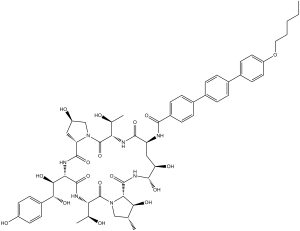This product is for research use only, not for human use. We do not sell to patients.

| Size | Price | Stock |
|---|---|---|
| 250mg | $480 | Check With Us |
| 500mg | $799 | Check With Us |
| 1g | $1200 | Check With Us |
Cat #: V1916 CAS #: 166663-25-8 Purity ≥ 98%
Description: Anidulafungin (formerly also named as LY303366; Eraxis; Ecalta), a novel semisynthetic echinocandin derivative, which inhibits glucan synthase activity, used as an antifungal drug. Anidulafungin has been reported to inhibit systemic isolates of Candida species with the MIC90 values of 0.08μg/ml, 0.32μg/ml, 0.32μg/ml and 5.12μg/ml for C.albicans (n=99), C.glabrata(n=18), C.tropicalis(n=10), and C.parapsilosis (n=10), respectively. In addition, Anidulafungin has been found to be active against Aspergillus species(n=20) with the MIC90 values of ~0.02μg/ml. Apart from these, Anidulafungin has been revealed to inactively restrain with the MIC90 values of >10.24μg/ml and 16μg/ml, for C.neoformans and B.dermatitidis, respectively .
Publications Citing InvivoChem Products
Product Promise

- Physicochemical and Storage Information
- Protocol
- Related Biological Data
- Stock Solution Preparation
- Quality Control Documentation
| Molecular Weight (MW) | 1140.24 |
|---|---|
| Molecular Formula | C58H73N7O17 |
| CAS No. | 166663-25-8 |
| Storage | -20℃ for 3 years in powder formr |
| -80℃ for 2 years in solvent | |
| Solubility In Vitro | DMSO: 100 mg/mL (87.7 mM)r |
| Water: <1 mg/mLr | |
| Ethanol: <1 mg/mL | |
| SMILES Code | CCCCCOC1=CC=C(C2=CC=C(C3=CC=C(C(N[C@@H]4C[C@@H](O)[C@@H](O)NC([C@@H]5[C@@H](O)[C@@H](C)CN5C([C@H]([C@@H](O)C)NC([C@H]([C@@H](O)[C@@H](O)C6=CC=C(O)C=C6)NC([C@@H]7C[C@@H](O)CN7C([C@H]([C@@H](O)C)NC4=O)=O)=O)=O)=O)=O)=O)C=C3)C=C2)C=C1 |
| Synonyms | LY303366; LY-303366; LY 303366; Vechinocandin; trade name: Eraxis; Ecalta. |
| Protocol | In Vitro | In vitro activity: Anidulafungin has been reported to inhibit systemic isolates of Candida species with the MIC90 values of 0.08μg/ml, 0.32μg/ml, 0.32μg/ml and 5.12μg/ml for C.albicans (n=99), C.glabrata(n=18), C.tropicalis(n=10), and C.parapsilosis (n=10), respectively. In addition, Anidulafungin has been found to be active against Aspergillus species(n=20) with the MIC90 values of ~0.02μg/ml. Apart from these, Anidulafungin has been revealed to inactively restrain with the MIC90 values of >10.24μg/ml and 16μg/ml, for C.neoformans and B.dermatitidis, respectively. Kinase Assay: Anidulafungin has been reported to inhibit systemic isolates of Candida species with the MIC90 values of 0.08μg/ml, 0.32μg/ml, 0.32μg/ml and 5.12μg/ml for C.albicans (n=99), C.glabrata(n=18), C.tropicalis(n=10), and C.parapsilosis (n=10), respectively. I Cell Assay: Stocks of CD101 (formerly SP 3025, biafungin, AF-025) are prepared fresh in 100% DMSO prior to use. The comparator antifungals Anidulafungin (ANF), Caspofungin (CSF), and Amphotericin B (AMB) are also prepared in 100% DMSO. MIC assays are performed via broth microdilution in accordance with CLSI guidelines, with the exception that test compounds are made up at a 50× final assay concentration and 100 μL assay mixture volumes are used (2 μL added to 98 μL of broth containing cells at 0.5×103 to 2.5×103 CFU/mL). All MIC assays are run at least three times, and a representative data set is shown. Quality control (QC) is assessed throughout the study via comparison of MIC values derived for WT C. krusei strain ATCC 6258 for AMB, CSF, and ANF with previously reported CLSI 24-h broth microdilution QC ranges. |
|---|
| Solvent volume to be added | Mass (the weight of a compound) | |||
|---|---|---|---|---|
| Mother liquor concentration | 1mg | 5mg | 10mg | 20mg |
| 1mM | 0.8770 mL | 4.3850 mL | 8.7701 mL | 17.5402 mL |
| 5mM | 0.1754 mL | 0.8770 mL | 1.7540 mL | 3.5080 mL |
| 10mM | 0.0877 mL | 0.4385 mL | 0.8770 mL | 1.7540 mL |
| 20mM | 0.0439 mL | 0.2193 mL | 0.4385 mL | 0.8770 mL |
This equation is commonly abbreviated as: C1 V1 = C2 V2
- (1) Please be sure that the solution is clear before the addition of next solvent. Dissolution methods like vortex, ultrasound or warming and heat may be used to aid dissolving.
- (2) Be sure to add the solvent(s) in order.




































